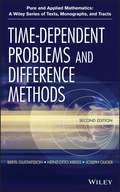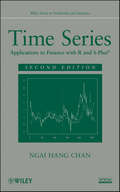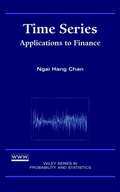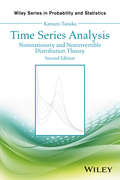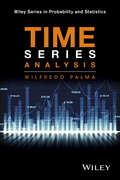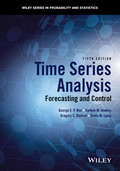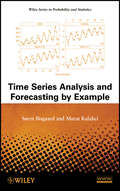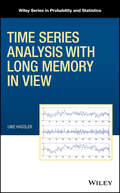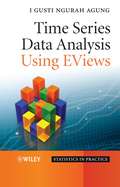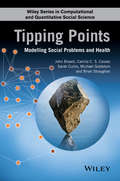- Table View
- List View
Ti-84 Plus Graphing Calculator For Dummies
by Jeff McCalla C. C. EdwardsGet up-to-speed on the functionality of your TI-84 Plus calculator Completely revised to cover the latest updates to the TI-84 Plus calculators, this bestselling guide will help you become the most savvy TI-84 Plus user in the classroom! Exploring the standard device, the updated device with USB plug and upgraded memory (the TI-84 Plus Silver Edition), and the upcoming color screen device, this book provides you with clear, understandable coverage of the TI-84's updated operating system. Details the new apps that are available for download to the calculator via the USB cable Walks you through menus and basic arithmetic Addresses graphing and analyzing functions as well as probability and statistics functions Explains how to use the calculator for geometry Reviews communicating with PCs and other calculators TI-84 Plus Graphic Calculator For Dummies, 2nd Edition is the perfect solution for getting comfortable with the new line of TI-84 calculators!
Ti-84 Plus Graphing Calculator For Dummies
by Jeff McCalla C. C. EdwardsGet up-to-speed on the functionality of your TI-84 Plus calculator Completely revised to cover the latest updates to the TI-84 Plus calculators, this bestselling guide will help you become the most savvy TI-84 Plus user in the classroom! Exploring the standard device, the updated device with USB plug and upgraded memory (the TI-84 Plus Silver Edition), and the upcoming color screen device, this book provides you with clear, understandable coverage of the TI-84's updated operating system. Details the new apps that are available for download to the calculator via the USB cable Walks you through menus and basic arithmetic Addresses graphing and analyzing functions as well as probability and statistics functions Explains how to use the calculator for geometry Reviews communicating with PCs and other calculators TI-84 Plus Graphic Calculator For Dummies, 2nd Edition is the perfect solution for getting comfortable with the new line of TI-84 calculators!
TI-89 Graphing Calculator For Dummies
by C. C. EdwardsDo you own a TI-89, TI-89 Titanium, TI-92 Plus, or a Voyage 200 graphing calculator? If you do, or if you need to get one for school or your job, then you need to know how it works and how to make the most of its functions. TI-89 For Dummies is the plain-English nuts-and-bolts guide that gets you up and running on all the things your TI-89 can do, quickly and easily. This hands-on reference guides you step by step through various tasks and even shows you how to add applications to your calculator. Soon you’ll have the tools you need to: Solve equations and systems of equations Factor polynomials Evaluate derivatives and integrals Graph functions, parametric equations, polar equations, and sequences Create Stat Plots and analyze statistical data Multiply matrices Solve differential equations and systems of differential equations Transfer files between two or more calculators Save calculator files on your computer Packed with exciting and valuable applications that you can download from the Internet and install through your computer, as well as common errors and messages with explanations and solutions, TI-89 For Dummies is the one-stop reference for all your graphing calculator questions!
TI-Nspire For Dummies
by Jeff McCalla Steve OuelletteThe updated guide to the newest graphing calculator from Texas Instruments The TI-Nspire graphing calculator is popular among high school and college students as a valuable tool for calculus, AP calculus, and college-level algebra courses. Its use is allowed on the major college entrance exams. This book is a nuts-and-bolts guide to working with the TI-Nspire, providing everything you need to get up and running and helping you get the most out of this high-powered math tool. Texas Instruments’ TI-Nspire graphing calculator is perfect for high school and college students in advanced algebra and calculus classes as well as students taking the SAT, PSAT, and ACT exams This fully updated guide covers all enhancements to the TI-Nspire, including the touchpad and the updated software that can be purchased along with the device Shows how to get maximum value from this versatile math tool With updated screenshots and examples, TI-Nspire For Dummies provides practical, hands-on instruction to help students make the most of this revolutionary graphing calculator.
Time-Dependent Problems and Difference Methods (Pure and Applied Mathematics: A Wiley Series of Texts, Monographs and Tracts #123)
by Bertil Gustafsson Heinz-Otto Kreiss Joseph OligerPraise for the First Edition ". . . fills a considerable gap in the numerical analysis literature by providing a self-contained treatment . . . this is an important work written in a clear style . . . warmly recommended to any graduate student or researcher in the field of the numerical solution of partial differential equations." —SIAM Review Time-Dependent Problems and Difference Methods, Second Edition continues to provide guidance for the analysis of difference methods for computing approximate solutions to partial differential equations for time-dependent problems. The book treats differential equations and difference methods with a parallel development, thus achieving a more useful analysis of numerical methods. The Second Edition presents hyperbolic equations in great detail as well as new coverage on second-order systems of wave equations including acoustic waves, elastic waves, and Einstein equations. Compared to first-order hyperbolic systems, initial-boundary value problems for such systems contain new properties that must be taken into account when analyzing stability. Featuring the latest material in partial differential equations with new theorems, examples, and illustrations,Time-Dependent Problems and Difference Methods, Second Edition also includes: High order methods on staggered grids Extended treatment of Summation By Parts operators and their application to second-order derivatives Simplified presentation of certain parts and proofs Time-Dependent Problems and Difference Methods, Second Edition is an ideal reference for physical scientists, engineers, numerical analysts, and mathematical modelers who use numerical experiments to test designs and to predict and investigate physical phenomena. The book is also excellent for graduate-level courses in applied mathematics and scientific computations.
Time-Dependent Problems and Difference Methods (Pure and Applied Mathematics: A Wiley Series of Texts, Monographs and Tracts #121)
by Bertil Gustafsson Heinz-Otto Kreiss Joseph OligerPraise for the First Edition ". . . fills a considerable gap in the numerical analysis literature by providing a self-contained treatment . . . this is an important work written in a clear style . . . warmly recommended to any graduate student or researcher in the field of the numerical solution of partial differential equations." —SIAM Review Time-Dependent Problems and Difference Methods, Second Edition continues to provide guidance for the analysis of difference methods for computing approximate solutions to partial differential equations for time-dependent problems. The book treats differential equations and difference methods with a parallel development, thus achieving a more useful analysis of numerical methods. The Second Edition presents hyperbolic equations in great detail as well as new coverage on second-order systems of wave equations including acoustic waves, elastic waves, and Einstein equations. Compared to first-order hyperbolic systems, initial-boundary value problems for such systems contain new properties that must be taken into account when analyzing stability. Featuring the latest material in partial differential equations with new theorems, examples, and illustrations,Time-Dependent Problems and Difference Methods, Second Edition also includes: High order methods on staggered grids Extended treatment of Summation By Parts operators and their application to second-order derivatives Simplified presentation of certain parts and proofs Time-Dependent Problems and Difference Methods, Second Edition is an ideal reference for physical scientists, engineers, numerical analysts, and mathematical modelers who use numerical experiments to test designs and to predict and investigate physical phenomena. The book is also excellent for graduate-level courses in applied mathematics and scientific computations.
Time Series: Applications to Finance with R and S-Plus
by Ngai Hang ChanA new edition of the comprehensive, hands-on guide to financial time series, now featuring S-Plus® and R software Time Series: Applications to Finance with R and S-Plus®, Second Edition is designed to present an in-depth introduction to the conceptual underpinnings and modern ideas of time series analysis. Utilizing interesting, real-world applications and the latest software packages, this book successfully helps readers grasp the technical and conceptual manner of the topic in order to gain a deeper understanding of the ever-changing dynamics of the financial world. With balanced coverage of both theory and applications, this Second Edition includes new content to accurately reflect the current state-of-the-art nature of financial time series analysis. A new chapter on Markov Chain Monte Carlo presents Bayesian methods for time series with coverage of Metropolis-Hastings algorithm, Gibbs sampling, and a case study that explores the relevance of these techniques for understanding activity in the Dow Jones Industrial Average. The author also supplies a new presentation of statistical arbitrage that includes discussion of pairs trading and cointegration. In addition to standard topics such as forecasting and spectral analysis, real-world financial examples are used to illustrate recent developments in nonstandard techniques, including: Nonstationarity Heteroscedasticity Multivariate time series State space modeling and stochastic volatility Multivariate GARCH Cointegration and common trends The book's succinct and focused organization allows readers to grasp the important ideas of time series. All examples are systematically illustrated with S-Plus® and R software, highlighting the relevance of time series in financial applications. End-of-chapter exercises and selected solutions allow readers to test their comprehension of the presented material, and a related Web site features additional data sets. Time Series: Applications to Finance with R and S-Plus® is an excellent book for courses on financial time series at the upper-undergraduate and beginning graduate levels. It also serves as an indispensible resource for practitioners working with financial data in the fields of statistics, economics, business, and risk management.
Time Series: Applications to Finance (Wiley Series in Probability and Statistics #487)
by Ngai Hang ChanElements of Financial Time Series fills a gap in the market in the area of financial time series analysis by giving both conceptual and practical illustrations. Examples and discussions in the later chapters of the book make recent developments in time series more accessible. Examples from finance are maximized as much as possible throughout the book. * Full set of exercises is displayed at the end of each chapter. * First seven chapters cover standard topics in time series at a high-intensity level. * Recent and timely developments in nonstandard time series techniques are illustrated with real finance examples in detail. * Examples are systemically illustrated with S-plus with codes and data available on an associated Web site.
Time Series Analysis: Nonstationary and Noninvertible Distribution Theory (Wiley Series in Probability and Statistics #4)
by Katsuto TanakaReflects the developments and new directions in the field since the publication of the first successful edition and contains a complete set of problems and solutions This revised and expanded edition reflects the developments and new directions in the field since the publication of the first edition. In particular, sections on nonstationary panel data analysis and a discussion on the distinction between deterministic and stochastic trends have been added. Three new chapters on long-memory discrete-time and continuous-time processes have also been created, whereas some chapters have been merged and some sections deleted. The first eleven chapters of the first edition have been compressed into ten chapters, with a chapter on nonstationary panel added and located under Part I: Analysis of Non-fractional Time Series. Chapters 12 to 14 have been newly written under Part II: Analysis of Fractional Time Series. Chapter 12 discusses the basic theory of long-memory processes by introducing ARFIMA models and the fractional Brownian motion (fBm). Chapter 13 is concerned with the computation of distributions of quadratic functionals of the fBm and its ratio. Next, Chapter 14 introduces the fractional Ornstein–Uhlenbeck process, on which the statistical inference is discussed. Finally, Chapter 15 gives a complete set of solutions to problems posed at the end of most sections. This new edition features: • Sections to discuss nonstationary panel data analysis, the problem of differentiating between deterministic and stochastic trends, and nonstationary processes of local deviations from a unit root • Consideration of the maximum likelihood estimator of the drift parameter, as well as asymptotics as the sampling span increases • Discussions on not only nonstationary but also noninvertible time series from a theoretical viewpoint • New topics such as the computation of limiting local powers of panel unit root tests, the derivation of the fractional unit root distribution, and unit root tests under the fBm error Time Series Analysis: Nonstationary and Noninvertible Distribution Theory, Second Edition, is a reference for graduate students in econometrics or time series analysis. Katsuto Tanaka, PhD, is a professor in the Faculty of Economics at Gakushuin University and was previously a professor at Hitotsubashi University. He is a recipient of the Tjalling C. Koopmans Econometric Theory Prize (1996), the Japan Statistical Society Prize (1998), and the Econometric Theory Award (1999). Aside from the first edition of Time Series Analysis (Wiley, 1996), Dr. Tanaka had published five econometrics and statistics books in Japanese.
Time Series Analysis (Wiley Series in Probability and Statistics)
by Wilfredo PalmaA modern and accessible guide to the analysis of introductory time series data Featuring an organized and self-contained guide, Time Series Analysis provides a broad introduction to the most fundamental methodologies and techniques of time series analysis. The book focuses on the treatment of univariate time series by illustrating a number of well-known models such as ARMA and ARIMA. Providing contemporary coverage, the book features several useful and newlydeveloped techniques such as weak and strong dependence, Bayesian methods, non-Gaussian data, local stationarity, missing values and outliers, and threshold models. Time Series Analysis includes practical applications of time series methods throughout, as well as: Real-world examples and exercise sets that allow readers to practice the presented methods and techniques Numerous detailed analyses of computational aspects related to the implementation of methodologies including algorithm efficiency, arithmetic complexity, and process time End-of-chapter proposed problems and bibliographical notes to deepen readers’ knowledge of the presented material Appendices that contain details on fundamental concepts and select solutions of the problems implemented throughout A companion website with additional data fi les and computer codes Time Series Analysis is an excellent textbook for undergraduate and beginning graduate-level courses in time series as well as a supplement for students in advanced statistics, mathematics, economics, finance, engineering, and physics. The book is also a useful reference for researchers and practitioners in time series analysis, econometrics, and finance. Wilfredo Palma, PhD, is Professor of Statistics in the Department of Statistics at Pontificia Universidad Católica de Chile. He has published several refereed articles and has received over a dozen academic honors and awards. His research interests include time series analysis, prediction theory, state space systems, linear models, and econometrics. He is the author of Long-Memory Time Series: Theory and Methods, also published by Wiley.
Time Series Analysis: Forecasting and Control (Wiley Series in Probability and Statistics #734)
by George E. Box Gwilym M. Jenkins Gregory C. Reinsel Greta M. LjungPraise for the Fourth Edition "The book follows faithfully the style of the original edition. The approach is heavily motivated by real-world time series, and by developing a complete approach to model building, estimation, forecasting and control."—Mathematical Reviews Bridging classical models and modern topics, the Fifth Edition of Time Series Analysis: Forecasting and Control maintains a balanced presentation of the tools for modeling and analyzing time series. Also describing the latest developments that have occurred in the field over the past decade through applications from areas such as business, finance, and engineering, the Fifth Edition continues to serve as one of the most influential and prominent works on the subject. Time Series Analysis: Forecasting and Control, Fifth Edition provides a clearly written exploration of the key methods for building, classifying, testing, and analyzing stochastic models for time series and describes their use in five important areas of application: forecasting; determining the transfer function of a system; modeling the effects of intervention events; developing multivariate dynamic models; and designing simple control schemes. Along with these classical uses, the new edition covers modern topics with new features that include: A redesigned chapter on multivariate time series analysis with an expanded treatment of Vector Autoregressive, or VAR models, along with a discussion of the analytical tools needed for modeling vector time series An expanded chapter on special topics covering unit root testing, time-varying volatility models such as ARCH and GARCH, nonlinear time series models, and long memory models Numerous examples drawn from finance, economics, engineering, and other related fields The use of the publicly available R software for graphical illustrations and numerical calculations along with scripts that demonstrate the use of R for model building and forecasting Updates to literature references throughout and new end-of-chapter exercises Streamlined chapter introductions and revisions that update and enhance the exposition Time Series Analysis: Forecasting and Control, Fifth Edition is a valuable real-world reference for researchers and practitioners in time series analysis, econometrics, finance, and related fields. The book is also an excellent textbook for beginning graduate-level courses in advanced statistics, mathematics, economics, finance, engineering, and physics.
Time Series Analysis: Nonstationary and Noninvertible Distribution Theory (Wiley Series in Probability and Statistics #4)
by Katsuto TanakaReflects the developments and new directions in the field since the publication of the first successful edition and contains a complete set of problems and solutions This revised and expanded edition reflects the developments and new directions in the field since the publication of the first edition. In particular, sections on nonstationary panel data analysis and a discussion on the distinction between deterministic and stochastic trends have been added. Three new chapters on long-memory discrete-time and continuous-time processes have also been created, whereas some chapters have been merged and some sections deleted. The first eleven chapters of the first edition have been compressed into ten chapters, with a chapter on nonstationary panel added and located under Part I: Analysis of Non-fractional Time Series. Chapters 12 to 14 have been newly written under Part II: Analysis of Fractional Time Series. Chapter 12 discusses the basic theory of long-memory processes by introducing ARFIMA models and the fractional Brownian motion (fBm). Chapter 13 is concerned with the computation of distributions of quadratic functionals of the fBm and its ratio. Next, Chapter 14 introduces the fractional Ornstein–Uhlenbeck process, on which the statistical inference is discussed. Finally, Chapter 15 gives a complete set of solutions to problems posed at the end of most sections. This new edition features: • Sections to discuss nonstationary panel data analysis, the problem of differentiating between deterministic and stochastic trends, and nonstationary processes of local deviations from a unit root • Consideration of the maximum likelihood estimator of the drift parameter, as well as asymptotics as the sampling span increases • Discussions on not only nonstationary but also noninvertible time series from a theoretical viewpoint • New topics such as the computation of limiting local powers of panel unit root tests, the derivation of the fractional unit root distribution, and unit root tests under the fBm error Time Series Analysis: Nonstationary and Noninvertible Distribution Theory, Second Edition, is a reference for graduate students in econometrics or time series analysis. Katsuto Tanaka, PhD, is a professor in the Faculty of Economics at Gakushuin University and was previously a professor at Hitotsubashi University. He is a recipient of the Tjalling C. Koopmans Econometric Theory Prize (1996), the Japan Statistical Society Prize (1998), and the Econometric Theory Award (1999). Aside from the first edition of Time Series Analysis (Wiley, 1996), Dr. Tanaka had published five econometrics and statistics books in Japanese.
Time Series Analysis (Wiley Series in Probability and Statistics)
by Wilfredo PalmaA modern and accessible guide to the analysis of introductory time series data Featuring an organized and self-contained guide, Time Series Analysis provides a broad introduction to the most fundamental methodologies and techniques of time series analysis. The book focuses on the treatment of univariate time series by illustrating a number of well-known models such as ARMA and ARIMA. Providing contemporary coverage, the book features several useful and newlydeveloped techniques such as weak and strong dependence, Bayesian methods, non-Gaussian data, local stationarity, missing values and outliers, and threshold models. Time Series Analysis includes practical applications of time series methods throughout, as well as: Real-world examples and exercise sets that allow readers to practice the presented methods and techniques Numerous detailed analyses of computational aspects related to the implementation of methodologies including algorithm efficiency, arithmetic complexity, and process time End-of-chapter proposed problems and bibliographical notes to deepen readers’ knowledge of the presented material Appendices that contain details on fundamental concepts and select solutions of the problems implemented throughout A companion website with additional data fi les and computer codes Time Series Analysis is an excellent textbook for undergraduate and beginning graduate-level courses in time series as well as a supplement for students in advanced statistics, mathematics, economics, finance, engineering, and physics. The book is also a useful reference for researchers and practitioners in time series analysis, econometrics, and finance. Wilfredo Palma, PhD, is Professor of Statistics in the Department of Statistics at Pontificia Universidad Católica de Chile. He has published several refereed articles and has received over a dozen academic honors and awards. His research interests include time series analysis, prediction theory, state space systems, linear models, and econometrics. He is the author of Long-Memory Time Series: Theory and Methods, also published by Wiley.
Time Series Analysis: Forecasting and Control (Wiley Series in Probability and Statistics)
by George E. Box Gwilym M. Jenkins Gregory C. Reinsel Greta M. LjungPraise for the Fourth Edition "The book follows faithfully the style of the original edition. The approach is heavily motivated by real-world time series, and by developing a complete approach to model building, estimation, forecasting and control."—Mathematical Reviews Bridging classical models and modern topics, the Fifth Edition of Time Series Analysis: Forecasting and Control maintains a balanced presentation of the tools for modeling and analyzing time series. Also describing the latest developments that have occurred in the field over the past decade through applications from areas such as business, finance, and engineering, the Fifth Edition continues to serve as one of the most influential and prominent works on the subject. Time Series Analysis: Forecasting and Control, Fifth Edition provides a clearly written exploration of the key methods for building, classifying, testing, and analyzing stochastic models for time series and describes their use in five important areas of application: forecasting; determining the transfer function of a system; modeling the effects of intervention events; developing multivariate dynamic models; and designing simple control schemes. Along with these classical uses, the new edition covers modern topics with new features that include: A redesigned chapter on multivariate time series analysis with an expanded treatment of Vector Autoregressive, or VAR models, along with a discussion of the analytical tools needed for modeling vector time series An expanded chapter on special topics covering unit root testing, time-varying volatility models such as ARCH and GARCH, nonlinear time series models, and long memory models Numerous examples drawn from finance, economics, engineering, and other related fields The use of the publicly available R software for graphical illustrations and numerical calculations along with scripts that demonstrate the use of R for model building and forecasting Updates to literature references throughout and new end-of-chapter exercises Streamlined chapter introductions and revisions that update and enhance the exposition Time Series Analysis: Forecasting and Control, Fifth Edition is a valuable real-world reference for researchers and practitioners in time series analysis, econometrics, finance, and related fields. The book is also an excellent textbook for beginning graduate-level courses in advanced statistics, mathematics, economics, finance, engineering, and physics.
Time Series Analysis and Forecasting by Example (Wiley Series in Probability and Statistics #301)
by Søren Bisgaard Murat KulahciAn intuition-based approach enables you to master time series analysis with ease Time Series Analysis and Forecasting by Example provides the fundamental techniques in time series analysis using various examples. By introducing necessary theory through examples that showcase the discussed topics, the authors successfully help readers develop an intuitive understanding of seemingly complicated time series models and their implications. The book presents methodologies for time series analysis in a simplified, example-based approach. Using graphics, the authors discuss each presented example in detail and explain the relevant theory while also focusing on the interpretation of results in data analysis. Following a discussion of why autocorrelation is often observed when data is collected in time, subsequent chapters explore related topics, including: Graphical tools in time series analysis Procedures for developing stationary, non-stationary, and seasonal models How to choose the best time series model Constant term and cancellation of terms in ARIMA models Forecasting using transfer function-noise models The final chapter is dedicated to key topics such as spurious relationships, autocorrelation in regression, and multiple time series. Throughout the book, real-world examples illustrate step-by-step procedures and instructions using statistical software packages such as SAS®, JMP, Minitab, SCA, and R. A related Web site features PowerPoint slides to accompany each chapter as well as the book's data sets. With its extensive use of graphics and examples to explain key concepts, Time Series Analysis and Forecasting by Example is an excellent book for courses on time series analysis at the upper-undergraduate and graduate levels. it also serves as a valuable resource for practitioners and researchers who carry out data and time series analysis in the fields of engineering, business, and economics.
Time Series Analysis with Long Memory in View (Wiley Series in Probability and Statistics #215)
by Uwe HasslerProvides a simple exposition of the basic time series material, and insights into underlying technical aspects and methods of proof Long memory time series are characterized by a strong dependence between distant events. This book introduces readers to the theory and foundations of univariate time series analysis with a focus on long memory and fractional integration, which are embedded into the general framework. It presents the general theory of time series, including some issues that are not treated in other books on time series, such as ergodicity, persistence versus memory, asymptotic properties of the periodogram, and Whittle estimation. Further chapters address the general functional central limit theory, parametric and semiparametric estimation of the long memory parameter, and locally optimal tests. Intuitive and easy to read, Time Series Analysis with Long Memory in View offers chapters that cover: Stationary Processes; Moving Averages and Linear Processes; Frequency Domain Analysis; Differencing and Integration; Fractionally Integrated Processes; Sample Means; Parametric Estimators; Semiparametric Estimators; and Testing. It also discusses further topics. This book: Offers beginning-of-chapter examples as well as end-of-chapter technical arguments and proofs Contains many new results on long memory processes which have not appeared in previous and existing textbooks Takes a basic mathematics (Calculus) approach to the topic of time series analysis with long memory Contains 25 illustrative figures as well as lists of notations and acronyms Time Series Analysis with Long Memory in View is an ideal text for first year PhD students, researchers, and practitioners in statistics, econometrics, and any application area that uses time series over a long period. It would also benefit researchers, undergraduates, and practitioners in those areas who require a rigorous introduction to time series analysis.
Time Series Analysis with Long Memory in View (Wiley Series in Probability and Statistics #215)
by Uwe HasslerProvides a simple exposition of the basic time series material, and insights into underlying technical aspects and methods of proof Long memory time series are characterized by a strong dependence between distant events. This book introduces readers to the theory and foundations of univariate time series analysis with a focus on long memory and fractional integration, which are embedded into the general framework. It presents the general theory of time series, including some issues that are not treated in other books on time series, such as ergodicity, persistence versus memory, asymptotic properties of the periodogram, and Whittle estimation. Further chapters address the general functional central limit theory, parametric and semiparametric estimation of the long memory parameter, and locally optimal tests. Intuitive and easy to read, Time Series Analysis with Long Memory in View offers chapters that cover: Stationary Processes; Moving Averages and Linear Processes; Frequency Domain Analysis; Differencing and Integration; Fractionally Integrated Processes; Sample Means; Parametric Estimators; Semiparametric Estimators; and Testing. It also discusses further topics. This book: Offers beginning-of-chapter examples as well as end-of-chapter technical arguments and proofs Contains many new results on long memory processes which have not appeared in previous and existing textbooks Takes a basic mathematics (Calculus) approach to the topic of time series analysis with long memory Contains 25 illustrative figures as well as lists of notations and acronyms Time Series Analysis with Long Memory in View is an ideal text for first year PhD students, researchers, and practitioners in statistics, econometrics, and any application area that uses time series over a long period. It would also benefit researchers, undergraduates, and practitioners in those areas who require a rigorous introduction to time series analysis.
Time Series Data Analysis Using EViews: Forecasting Using Eviews
by I. Gusti AgungDo you want to recognize the most suitable models for analysis of statistical data sets? This book provides a hands-on practical guide to using the most suitable models for analysis of statistical data sets using EViews - an interactive Windows-based computer software program for sophisticated data analysis, regression, and forecasting - to define and test statistical hypotheses. Rich in examples and with an emphasis on how to develop acceptable statistical models, Time Series Data Analysis Using EViews is a perfect complement to theoretical books presenting statistical or econometric models for time series data. The procedures introduced are easily extendible to cross-section data sets. The author: Provides step-by-step directions on how to apply EViews software to time series data analysis Offers guidance on how to develop and evaluate alternative empirical models, permitting the most appropriate to be selected without the need for computational formulae Examines a variety of times series models, including continuous growth, discontinuous growth, seemingly causal, regression, ARCH, and GARCH as well as a general form of nonlinear time series and nonparametric models Gives over 250 illustrative examples and notes based on the author's own empirical findings, allowing the advantages and limitations of each model to be understood Describes the theory behind the models in comprehensive appendices Provides supplementary information and data sets An essential tool for advanced undergraduate and graduate students taking finance or econometrics courses. Statistics, life sciences, and social science students, as well as applied researchers, will also find this book an invaluable resource.
Time Series Data Analysis Using EViews
by I. Gusti AgungDo you want to recognize the most suitable models for analysis of statistical data sets? This book provides a hands-on practical guide to using the most suitable models for analysis of statistical data sets using EViews - an interactive Windows-based computer software program for sophisticated data analysis, regression, and forecasting - to define and test statistical hypotheses. Rich in examples and with an emphasis on how to develop acceptable statistical models, Time Series Data Analysis Using EViews is a perfect complement to theoretical books presenting statistical or econometric models for time series data. The procedures introduced are easily extendible to cross-section data sets. The author: Provides step-by-step directions on how to apply EViews software to time series data analysis Offers guidance on how to develop and evaluate alternative empirical models, permitting the most appropriate to be selected without the need for computational formulae Examines a variety of times series models, including continuous growth, discontinuous growth, seemingly causal, regression, ARCH, and GARCH as well as a general form of nonlinear time series and nonparametric models Gives over 250 illustrative examples and notes based on the author's own empirical findings, allowing the advantages and limitations of each model to be understood Describes the theory behind the models in comprehensive appendices Provides supplementary information and data sets An essential tool for advanced undergraduate and graduate students taking finance or econometrics courses. Statistics, life sciences, and social science students, as well as applied researchers, will also find this book an invaluable resource.
Tipping Points: Modelling Social Problems and Health (Wiley Series in Computational and Quantitative Social Science)
by Brian Straughan John Bissell Camila Caiado Michael Goldstein Sarah CurtisThis book focuses on the modelling of contemporary health and social problems, especially those considered a major burden to communities, governments and taxpayers, such as smoking, alcoholism, drug use, and heart disease. Based on a series of papers presented at a recent conference hosted by the Leverhulme-funded Tipping Points project at the University of Durham, this book illustrates a broad range of modelling approaches. Such a diverse collection demonstrates that an interdisciplinary approach is essential to modelling tipping points in health and social problems, and the assessment of associated risk and resilience.
Tipping Points: Modelling Social Problems and Health (Wiley Series in Computational and Quantitative Social Science)
by John Bissell Camila Caiado Sarah Curtis Michael Goldstein Brian StraughanThis book focuses on the modelling of contemporary health and social problems, especially those considered a major burden to communities, governments and taxpayers, such as smoking, alcoholism, drug use, and heart disease. Based on a series of papers presented at a recent conference hosted by the Leverhulme-funded Tipping Points project at the University of Durham, this book illustrates a broad range of modelling approaches. Such a diverse collection demonstrates that an interdisciplinary approach is essential to modelling tipping points in health and social problems, and the assessment of associated risk and resilience.
Topology: Point-Set and Geometric (Pure and Applied Mathematics: A Wiley Series of Texts, Monographs and Tracts #83)
by Paul L. ShickThe essentials of point-set topology, complete with motivation and numerous examples Topology: Point-Set and Geometric presents an introduction to topology that begins with the axiomatic definition of a topology on a set, rather than starting with metric spaces or the topology of subsets of Rn. This approach includes many more examples, allowing students to develop more sophisticated intuition and enabling them to learn how to write precise proofs in a brand-new context, which is an invaluable experience for math majors. Along with the standard point-set topology topics—connected and path-connected spaces, compact spaces, separation axioms, and metric spaces—Topology covers the construction of spaces from other spaces, including products and quotient spaces. This innovative text culminates with topics from geometric and algebraic topology (the Classification Theorem for Surfaces and the fundamental group), which provide instructors with the opportunity to choose which "capstone" best suits his or her students. Topology: Point-Set and Geometric features: A short introduction in each chapter designed to motivate the ideas and place them into an appropriate context Sections with exercise sets ranging in difficulty from easy to fairly challenging Exercises that are very creative in their approaches and work well in a classroom setting A supplemental Web site that contains complete and colorful illustrations of certain objects, several learning modules illustrating complicated topics, and animations of particularly complex proofs
Topology and Its Applications (Pure and Applied Mathematics: A Wiley Series of Texts, Monographs and Tracts #70)
by William F. BasenerDiscover a unique and modern treatment of topology employing a cross-disciplinary approach Implemented recently to understand diverse topics, such as cell biology, superconductors, and robot motion, topology has been transformed from a theoretical field that highlights mathematical theory to a subject that plays a growing role in nearly all fields of scientific investigation. Moving from the concrete to the abstract, Topology and Its Applications displays both the beauty and utility of topology, first presenting the essentials of topology followed by its emerging role within the new frontiers in research. Filling a gap between the teaching of topology and its modern uses in real-world phenomena, Topology and Its Applications is organized around the mathematical theory of topology, a framework of rigorous theorems, and clear, elegant proofs. This book is the first of its kind to present applications in computer graphics, economics, dynamical systems, condensed matter physics, biology, robotics, chemistry, cosmology, material science, computational topology, and population modeling, as well as other areas of science and engineering. Many of these applications are presented in optional sections, allowing an instructor to customize the presentation. The author presents a diversity of topological areas, including point-set topology, geometric topology, differential topology, and algebraic/combinatorial topology. Topics within these areas include: Open sets Compactness Homotopy Surface classification Index theory on surfaces Manifolds and complexes Topological groups The fundamental group and homology Special "core intuition" segments throughout the book briefly explain the basic intuition essential to understanding several topics. A generous number of figures and examples, many of which come from applications such as liquid crystals, space probe data, and computer graphics, are all available from the publisher's Web site.
Topology and Its Applications (Pure and Applied Mathematics: A Wiley Series of Texts, Monographs and Tracts #70)
by William F. BasenerDiscover a unique and modern treatment of topology employing a cross-disciplinary approach Implemented recently to understand diverse topics, such as cell biology, superconductors, and robot motion, topology has been transformed from a theoretical field that highlights mathematical theory to a subject that plays a growing role in nearly all fields of scientific investigation. Moving from the concrete to the abstract, Topology and Its Applications displays both the beauty and utility of topology, first presenting the essentials of topology followed by its emerging role within the new frontiers in research. Filling a gap between the teaching of topology and its modern uses in real-world phenomena, Topology and Its Applications is organized around the mathematical theory of topology, a framework of rigorous theorems, and clear, elegant proofs. This book is the first of its kind to present applications in computer graphics, economics, dynamical systems, condensed matter physics, biology, robotics, chemistry, cosmology, material science, computational topology, and population modeling, as well as other areas of science and engineering. Many of these applications are presented in optional sections, allowing an instructor to customize the presentation. The author presents a diversity of topological areas, including point-set topology, geometric topology, differential topology, and algebraic/combinatorial topology. Topics within these areas include: Open sets Compactness Homotopy Surface classification Index theory on surfaces Manifolds and complexes Topological groups The fundamental group and homology Special "core intuition" segments throughout the book briefly explain the basic intuition essential to understanding several topics. A generous number of figures and examples, many of which come from applications such as liquid crystals, space probe data, and computer graphics, are all available from the publisher's Web site.
The Topology of Chaos: Alice in Stretch and Squeezeland
by Robert Gilmore Marc LefrancA highly valued resource for those who wish to move from the introductory and preliminary understandings and the measurement of chaotic behavior to a more sophisticated and precise understanding of chaotic systems. The authors provide a deep understanding of the structure of strange attractors, how they are classified, and how the information required to identify and classify a strange attractor can be extracted from experimental data. In its first edition, the Topology of Chaos has been a valuable resource for physicist and mathematicians interested in the topological analysis of dynamical systems. Since its publication in 2002, important theoretical and experimental advances have put the topological analysis program on a firmer basis. This second edition includes relevant results and connects the material to other recent developments. Following significant improvements will be included: * A gentler introduction to the topological analysis of chaotic systems for the non expert which introduces the problems and questions that one commonly encounters when observing a chaotic dynamics and which are well addressed by a topological approach: existence of unstable periodic orbits, bifurcation sequences, multistability etc. * A new chapter is devoted to bounding tori which are essential for achieving generality as well as for understanding the influence of boundary conditions. * The new edition also reflects the progress which had been made towards extending topological analysis to higher-dimensional systems by proposing a new formalism where evolving triangulations replace braids. * There has also been much progress in the understanding of what is a good representation of a chaotic system, and therefore a new chapter is devoted to embeddings. * The chapter on topological analysis program will be expanded to cover traditional measures of chaos. This will help to connect those readers who are familiar with those measures and tests to the more sophisticated methodologies discussed in detail in this book. * The addition of the Appendix with both frequently asked and open questions with answers gathers the most essential points readers should keep in mind and guides to corresponding sections in the book. This will be of great help to those who want to selectively dive into the book and its treatments rather than reading it cover to cover. What makes this book special is its attempt to classify real physical systems (e.g. lasers) using topological techniques applied to real date (e.g. time series). Hence it has become the experimenter?s guidebook to reliable and sophisticated studies of experimental data for comparison with candidate relevant theoretical models, inevitable to physicists, mathematicians, and engineers studying low-dimensional chaotic systems.



